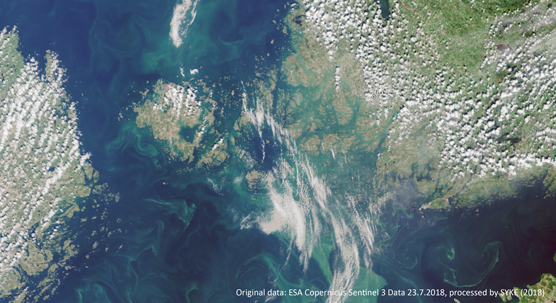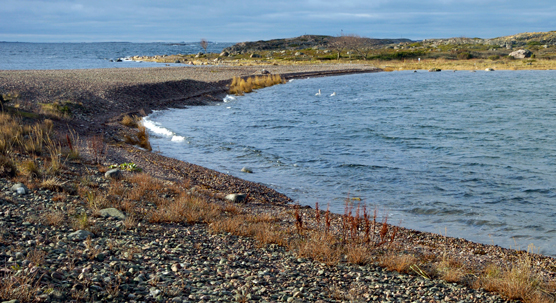Press release 2020-06-23 at 8:00
Despite long-term work on water protection, the condition of the marine environment of the Archipelago Sea has not improved as hoped. The aim has been to improve the condition of the sea with water protection measures in the catchment area, but the amount of nutrients in the Archipelago Sea, phosphorus in particular, has only decreased slightly. The MAAMERI research project is a part of the water protection enhancement programme; it aims to investigate the effects of reducing the phosphorus load coming from land on the marine environment in more detail and understand how the recovery of the environment could be enhanced.

The project aims to develop new tools based on satellite measurements and ecosystem modelling. © Original data: ESA Copernicus Sentinel 3 Data 23.7.2018, processed by SYKE (2018)
The project improves the knowledge base and develops tools for the planning and assessment of water protection measures further. The research focuses especially on measuring the particulate matter that ends up in the water. It also studies the seafloor sediment processes and the interaction between the phosphorus load and the biota that manifests e.g. in algal blooms. In addition, new tools based on satellite measurements and ecosystem modelling are developed.
The two-and-a-half-year project gathers Finnish marine research actors together on a wide front. The total budget of the project is approximately EUR 2.2 million. The project is led by the Finnish Environment Institute (SYKE), and its participants include the Geological Survey of Finland (GTK), the Finnish Meteorological Institute, Åbo Akademi, the University of Turku, the University of Helsinki, as well as the Centre for Economic Development, Transport and the Environment for Southwest Finland.
Nutrient load comes from several different sources – diffuse sources are the largest contributor to the load on the Archipelago Sea
The nutrient load on waters comes from many sources: municipal wastewater, industry, fish farming, agriculture, rural settlement, forestry, atmospheric deposition and storm waters. Most of the nutrient load on many Finnish sea areas, the Archipelago Sea included, is still due to diffuse loads, such as the load from agriculture.

Most of the nutrient load on many Finnish sea areas, the Archipelago Sea included, is still due to diffuse loads, such as the load from agriculture. © Riku Lumiaro / SYKE
The load coming from land changes on its way from the source to the sea and further from estuaries to open sea due to the hydrology of the area and the characteristics of the waterways. In coastal areas and the open sea, many simultaneous physical, chemical and biological processes affect the cycling of nutrients. For example, the biogeochemical processes of the sediment and the oxygen situation of the seabed have a significant impact on the phosphorus cycling.
The planning of measures requires tools that work well
To support the planning of water and marine environment management measures, tools are needed for assessing the goals set on reducing the load, as well as the related uncertainty, with a view to the good condition of the marine environment. Such tools, as the currently used Archipelago Sea model, are developed and improved in the MAAMERI project. The project is based on the existing long-term work on understanding and controlling the nutrient load of the Archipelago Sea and complements it.
“Our goal is to improve tools and make them more accurate and effective with the help of things like standardising the data of research institutes, as well as new material based on field studies and satellite images in particular. The work done in the MAAMERI project includes not only modelling and remote sensing, among other things, but also field studies conducted in the Archipelago Sea. In the field studies, we can take advantage of the strengths of the participating organisations’ expertise and research vessels of different sizes. Together we can produce important information on the ecosystem of the Archipelago Sea that is still missing,” says the leader of the research project, Senior Researcher Hermanni Kaartokallio from SYKE. “Our goal is to develop tools that can help achieve the good condition of coastal waters by using measures that are as cost-effective as possible.”
The water protection enhancement programme 2019–2023 started by the Ministry of the Environment is an important investment in water protection: its goal is the good status of the Baltic Sea and inland waters. The measures of the programme are used to clean oil from shipwrecks, restore water bodies and reduce the amount of harmful substances in urban water discharge as well as the nutrient load from agriculture and forestry to water bodies.
Further information:
- Senior Researcher Hermanni Kaartokallio, Finnish Environment Institute, tel. +358 50 3257 580, firstname.lastname@ymparisto.fi
- Research Professor Aarno Kotilainen, Geological Survey of Finland, tel. +358 295 032 576, aarno.kotilainen@gtk.fi
- Head of Group Laura Tuomi, Finnish Meteorological Institute, tel. +358 295 396 404, laura.tuomi@fmi.fi
- Senior Research Associate Sonja Salovius-Laurén, Åbo Akademi tel. + 358 40 7426 672, sonja.salovius-lauren@abo.fi
- Associate Professor Jari Hänninen, University of Turku, Archipelago Research Institute. tel. +358 50 4017 838, jarhan@utu.fi
- Professor Alf Norkko, University of Helsinki, Tvärminne Research Station. tel. +358 40 4846 608, alf.norkko@helsinki.fi
- Head of Unit Mirja Koskinen, ELY Centre for Southwest Finland. tel. +358 295 022 886, mirja.koskinen@ely-keskus.fi